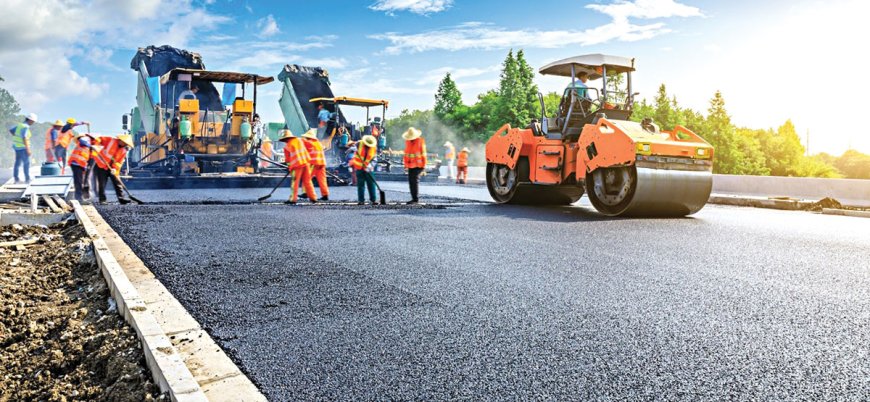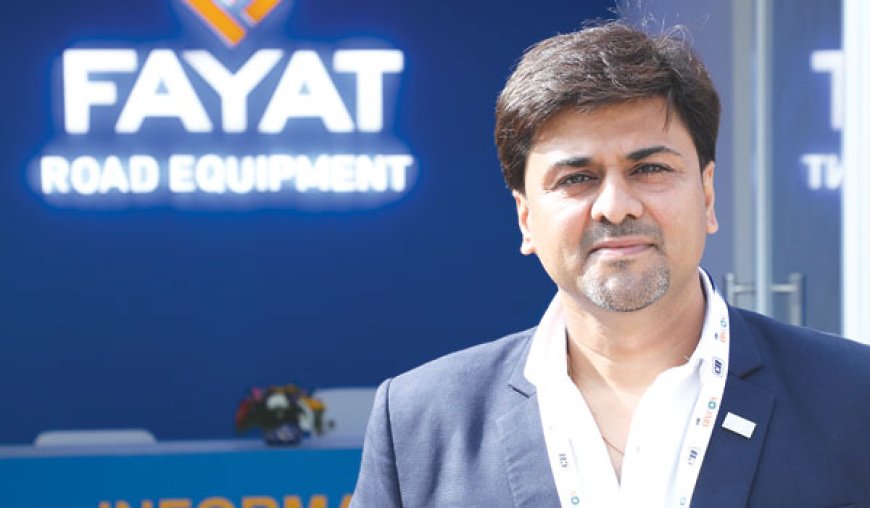ENGINEERED FOR EXCELLENCE

Enhancing Efficiency in Road Construction Equipment
In the vast network of highways and byways that crisscross our landscapes, road equipment stands as the silent sentinel of transportation infrastructure. From the mighty asphalt pavers to the humble road rollers, these machines are the heroes that ensure our journeys are smooth, safe, and efficient. However, behind their seemingly simple operation lies a world of complexity and potential for optimization.
Equipment Times delves into the realm of road equipment performance optimization, exploring the innovative strategies and technologies driving efficiency and safety on our roads.
Efficiency is the cornerstone of modern transportation infrastructure. With growing populations and increasing demands on our road networks, the need to optimize the performance of road equipment has never been greater. Every minute of downtime, every drop-in productivity, reverberates through the entire system, leading to congestion, delays, and increased costs. The challenge, therefore, lies in maximizing the uptime and productivity of road equipment while minimizing maintenance, fuel consumption, and environmental impact.
In recent years, advancements in technology have revolutionized the field of road equipment performance optimization. From telematics and IoT sensors to AI-powered analytics and predictive maintenance, a suite of innovative tools is now at the disposal of road maintenance crews and equipment manufacturers. These technologies enable real-time monitoring of equipment health, predictive identification of maintenance needs, and data-driven decision-making for optimal performance.
Real-Time Monitoring and Diagnostics…
One of the most significant developments in road equipment optimization is the advent of real-time monitoring and diagnostics systems. Equipped with sensors that monitor everything from engine performance to hydraulic pressure, these systems provide invaluable insights into the health and status of road equipment. By continuously analyzing this data, maintenance crews can detect potential issues before they escalate into costly breakdowns, allowing for proactive maintenance and minimizing downtime.
Technological Trends in Road Equipment…
In recent years, India has seen several technological trends emerge in road equipment aimed at improving efficiency, safety, and sustainability in road construction and maintenance.
Smart Construction Equipment: Road construction machinery is becoming increasingly integrated with smart technologies such as IoT sensors, GPS, and telematics. These technologies enable real-time monitoring of equipment performance, fuel consumption, and maintenance needs, leading to better resource utilization and reduced downtime.
Automation and Robotics: Automation is gaining traction in road construction processes, with the adoption of automated pavers, road rollers, and grading equipment. These machines offer higher precision, faster operation, and reduced labor requirements, contributing to overall project efficiency.
Green Technologies: With a growing emphasis on sustainability, there’s a rising demand for road equipment that minimizes environmental impact. This includes the use of eco-friendly materials in construction, as well as the development of electric and hybrid-powered machinery to reduce carbon emissions and noise pollution.
Advanced Materials: Innovations in materials science are influencing road construction practices. This includes the use of recycled materials such as reclaimed asphalt pavement (RAP) and recycled concrete aggregates (RCA), as well as the development of high-performance asphalt mixes and polymer-modified bitumen for improved durability and longevity of roads.
Digital Twins and Modeling: Digital twin technology is being applied to road infrastructure projects, allowing planners and engineers to create virtual replicas of roads and analyze various scenarios for optimal design and maintenance strategies. This helps in predicting maintenance needs, optimizing traffic flow, and reducing lifecycle costs.
Drones and UAVs: Unmanned aerial vehicles (UAVs) are increasingly used for aerial surveys, mapping, and monitoring of road construction sites. Drones equipped with cameras and LiDAR sensors can provide high-resolution imagery and 3D mapping data, aiding in project planning, progress tracking, and quality control.
Augmented Reality (AR) & Virtual Reality (VR): AR and VR technologies are being employed for training purposes, equipment simulation, and visualizing construction plans. This enhances safety, improves training effectiveness, and allows stakeholders to experience road projects in a virtual environment before implementation.
Data Analytics & Predictive Maintenance: Big data analytics and machine learning algorithms are being utilized to analyze vast amounts of data collected from road equipment sensors. This enables predictive maintenance strategies, identifying potential equipment failures before they occur, thereby minimizing downtime and optimizing maintenance schedules.
Predictive Maintenance…
Predictive maintenance takes the concept of real-time monitoring a step further by leveraging AI and machine learning algorithms to predict equipment failures before they occur. By analyzing historical performance data and identifying patterns and trends, these systems can anticipate maintenance needs, optimize maintenance schedules, and prevent unplanned downtime. This proactive approach not only maximizes equipment uptime but also extends the lifespan of critical components, reducing overall maintenance costs.
Optimizing Fuel Efficiency…
Fuel consumption is a significant operating expense for road equipment operators, and optimizing fuel efficiency is paramount for cost savings and environmental sustainability. Advanced engine management systems, hybrid powertrains, and alternative fuels are some of the strategies employed to minimize fuel consumption and reduce emissions. Additionally, telematics systems that track fuel usage in real-time enable operators to identify inefficiencies and implement corrective measures, such as optimizing routes and reducing idle time.
Enhancing Safety Through Technology…
Beyond efficiency, road equipment optimization also plays a crucial role in enhancing safety for both equipment operators and road users. Collision avoidance systems, backup cameras, and proximity sensors are some of the safety technologies incorporated into modern road equipment to mitigate the risk of accidents and injuries. Furthermore, intelligent automation features, such as automatic grade and slope control, enable operators to perform tasks with greater precision and consistency, minimizing the potential for human error.
The Road Ahead…
As we look to the future, the optimization of road equipment performance will continue to evolve, driven by advancements in technology and the imperative for sustainability and safety. From autonomous construction vehicles to 3D printing of road infrastructure, the possibilities are limitless. However, realizing this vision will require collaboration and innovation across the entire ecosystem of stakeholders, including equipment manufacturers, government agencies, and research institutions. By harnessing the power of technology and collective expertise, we can pave the way for a smoother, safer, and more efficient journey ahead on the roads of tomorrow.
Leaders speak…

V. G. Sakthikumar, CMD, Schwing Stetter India, said, “Schwing Stetter India’s road equipment is designed with a focus on efficiency and durability. Our motor graders are equipped with advanced CRDi electronic engines and ZF transmissions with auto/manual gear shifting for optimal performance. They also feature variable pistons, which help reduce operating costs and improve fuel efficiency. Additionally, we integrate “NO-SPIN” technology and self-locking differentials for enhanced anti-skid performance. Our dedicated training department, active since 2004, provides comprehensive training programs for operators. These programs focus on maximizing the performance of our road equipment through best practices, safety guidelines, and efficient operation techniques. We also offer technical support, preventive maintenance contracts, and troubleshooting assistance to ensure operators have the knowledge and resources to get the most out of our machines. The future of road equipment will likely involve greater integration of IoT, telematics, and automation. Schwing Stetter India aims to stay at the forefront of these developments by investing in R&D and leveraging technology to optimize performance. We envision smarter equipment that can self-diagnose issues, offer predictive maintenance, and improve overall efficiency and productivity.”

Rajesh Kaul, Vice President & Business Head – Trucks, Tata Motors, said, “Tata Motors boasts the widest range of trucks in the industry. This has been continually enhanced with the introduction of innovative models, state-of-the-art technology and advanced features – all geared towards optimising efficiency and ensuring high uptime for customers. We go beyond the mandatory norms to make our vehicles safer, smarter and greener at every opportunity such that they are ready to service the immediate needs of the customer and also their evolving needs of tomorrow. Tata Motors’ trucks promise enhanced drivability, faster turnarounds, increased productivity and greater revenue, ensuring consistent profitability for businesses. These tippers are a testament to the company’s dedication to incorporating cutting-edge technology, ensuring top-notch performance and prioritising safety throughout their operational lifespan. Our product portfolio is periodically updated and any white space and emerging requirements are captured based on environment scans, surveys and existing customer insights captured in our system. Each identified new opportunity then goes through rigorous evaluation in terms of meeting market requirement and business case at each gateway from concept to launch.”

Vishwesh Rai, General Manager, Fayat Road Equipment - Sales India, said, “CE Industry is heavily dependent on the machine operator. A skilled and well-trained operator is the need of the hour and plays an important role in ensuring enhanced stakeholder experience, Safety at Worksite and ultimately profitability. We at DYNAPAC are collaborating with IESC to develop a DYNAPAC Course Curriculum for Operator Training. The Curriculum will focus of training operators with Machine Operations, Preventive Maintenance and Safety, Health & Environment. The program will be conducted through professionally run certified training partners, Dealer Training Centers & hands on machine training at site. Currently, we are also running Dealer Operator & Technician trainings at our factory site in Pune. The vision for the future is to deliver DYNAPAC know how through direct as well as partner training centres pan India. Industry is driving for bringing innovation in technology that can reduce construction time and cost. With a wide range of product portfolio as well as our global presence we are trying to bring new solutions to our customers to meet this need. This has been amply demonstrated in our product introductions in last two years from our Pune plant. Changing for better is in Dynapac’s DNA. Since last eight decades, Dynapac has always been at the forefront of sensing the environmental, technological and developmental changes. And we are also the first to fully operationalize these changes in our widest range of products and other offerings.”

Puneet Vidyarthi, Head of Marketing and Business Development, India & SAARC – CASE Construction Equipment, said, “As we take smaller steps towards achieving the goal of Viksit Bharat (Developed India), it is important to consider sustainability as one of the key drivers. Hence, we have always prioritized sustainability as one of the hygiene factors that we should maintain in the industry.
The new emission standard, CEV V, is the next milestone that the industry will be adopting to reach a new sustainable level. It will officially take effect on 1 January 2025. Nevertheless, we at CASE are ready with our machinery, upgraded to comply with the new emission norms. We have already showcased our CEV V machines recently at EXCON 2023. Although CEV III machines are still present in the market, we have upgraded all our equipment to CEV IV, which represents a significant step towards emission reduction. CASE Construction is always aligned with the industry and ready to adopt upgrades. CASE emphasizes proactive maintenance practices and comprehensive aftermarket support to ensure the long-term performance of our road equipment. We maintain a robust inventory of genuine CASE spare parts and operate an extensive network of authorized service centers and dealerships nationwide, facilitating quick response times for maintenance and repairs. Our FLEETPRO solution caters to existing customers with older equipment, providing the right replacement parts and offering comprehensive aftermarket solutions. With a dedicated team of trained and certified personnel across 70 dealers and 200 touchpoints in India, backed by state-of-the-art warehouses and depots, we ensure easy access to spare parts throughout the country.”








